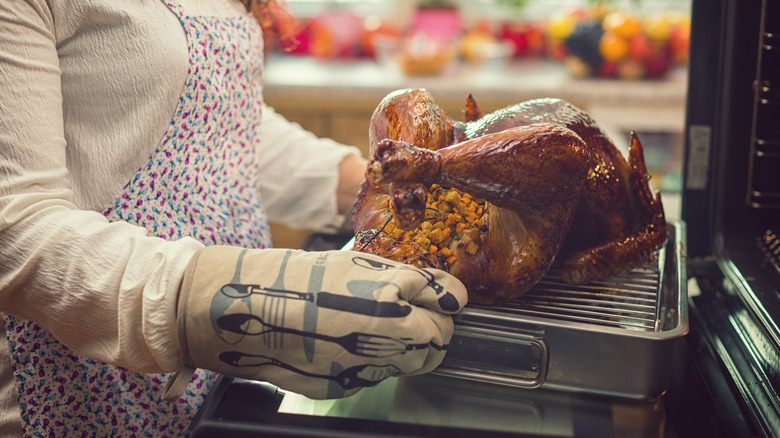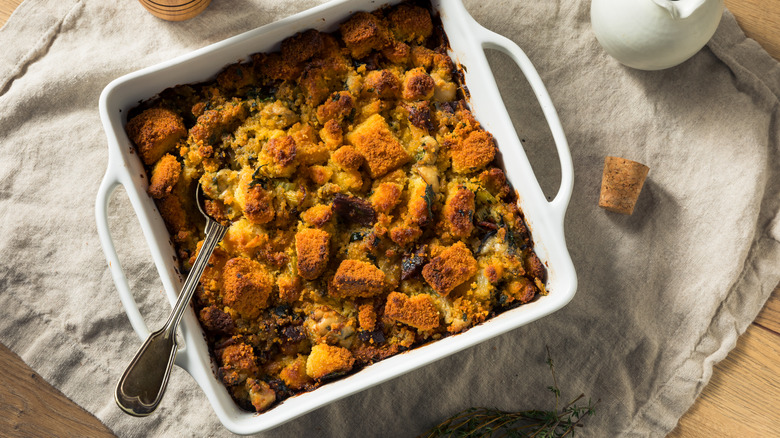What's The Actual Difference Between Dressing And Stuffing?
"Is it technically called stuffing or dressing?" you ask (or shout) across the Thanksgiving dinner table as loved ones become strangers and take their place in one camp or the other. The long-standing perennial debate is a highly personal one, considering the terms are used interchangeably depending on regional vernacular. Still, the difference between these dishes is more than just semantic, and one of the trickiest aspects of distinguishing these rich, starchy beauties from each other is the fact that they're made from basically the same ingredients.
Both dishes are mixtures of dried, stale, cubed bread and veggies seasoned with herbs, and are typically paired with a roasted turkey or chicken. It's all about bread, broth, and aromatics, and from this general blueprint, variations can spin off. Stuffings and dressings can be made with different types of bread and veggies — aromatics like parsley, sage, rosemary, and thyme are common(rise up, Simon & Garfunkel fans).
Onions, celery, and chicken or turkey stock are largely universal, but these dishes can also include leeks, carrots, bell peppers, mushrooms, raisins, cranberries, apples, crushed pecans, walnuts, pine nuts, and sometimes ground meat like sausage or eggs as a binding agent. Other versions include chestnut stuffing, autumn country stuffing, and New England oyster dressing. Colloquialisms aside, the biggest difference between these dishes is that stuffing is literally stuffed into the empty cavity of a whole-roasted turkey or chicken, while dressing is prepared as a separate side dish.
What is stuffing?
Stuffing is physically stuffed into the hollow cavity inside a roasted turkey or roasted chicken. As its name implies, the "stuffing" aspect is chiefly about the way it's served, having less to do with any different ingredients than with the preparation method. Although, the act of stuffing the herbed bread mixture into the bird does yield a pretty significantly different flavor compared to dressing. The juices of the roasted meat soak into the veggies and bread, making for a moister, more savory bite.
Stuffing a whole bird roast traditionally happens while the meat is still raw, with all of the flavors melding together and the stuffing softening during cooking. But that flavorful upgrade comes with a price: the risk of foodborne bacteria. In fact, the USDA actually advises against this preparation method, instead encouraging you to cook the stuffing outside of the bird, then stuff it post-cook. If you do cook the stuffing inside the turkey, plunge a food thermometer into the bread post-cook to make sure it's safe to eat. It should display an internal temperature of 165 degrees Fahrenheit.
What is dressing?
The most obvious difference separating dressing from stuffing is that dressing is served as a side dish alongside roasted poultry rather than stuffed inside of the bird. Consequently, since it's cooked in a separate casserole dish, there's no risk of cross contamination from raw meat, so dressing doesn't require a minimum cooking temperature to be safe to eat, unless you're working with ground meat of any sort.
Funnily enough, if you follow the package directions for cooking a box of Stove Top brand boxed stuffing on the titular stovetop — unless you physically insert the contents into a turkey afterwards — then it should actually be called Stove Top "dressing." Dressing also generally tends to be denser and wetter than stuffing, like a savory pudding more than a chunky chutney.
Notably, whether stuffed in or served on the side, foodies are more likely to call this savory holiday staple "dressing" if they live below the Mason-Dixon line. According to a 2015 survey by turkey giant Butterball, "dressing" is the dominant term for this dish (regardless of serving style) in the South and Midwest. American foodies in the rest of the country favor the term "stuffing," with the most non-interchangeable fidelity to the term in the Northeast and West Coast. Where sourdough and white breads are the more common choice for Northern foodies, Southern dressings often use cornbread, which makes for a sweeter flavor and more crumbly texture.


